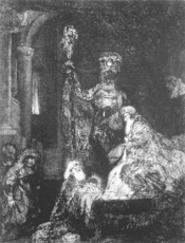Historically, printmaking (or, more accurately, the appreciation of printmaking) has been haunted by what scholar Susan Tallman has called the "neither fish nor fowl problem." Said Tallman in her 1996 book, The Contemporary Print: "Partly handmade and partly automated, partly popular and partly elitist, the original print has struck many as either a fussy little craft, or as posters with pretensions." The underlying assumption is that, since printmaking allowed artists to reap the rewards of endless reproductions of their work, the entire pursuit was somehow tainted with overtones of opportunism. This exhibit challenges such stereotyping. Much of the work here has been created by artists who have worked in the medium because they felt it offered them the best tool for realizing their artistic visions. Yes, there are examples of routine, economically motivated works (to have excluded them would have misrepresented a significant slice of printmaking's past), but there are also several examples by artists who, in Tallman's succinct phrase, "produced masterpieces that could not have been produced in any other way."
The Rembrandt works in this show are outstanding. There are only two, but here, in the most vivid way, one sees how the 17th-century Dutch artist could use the printmaking medium to create work in which form and content are fused into a powerful unit. Take the 1658 etching titled "Woman Bathing Her Feet in Brook." A nude woman is shown turned three quarters, her face hidden by shadows. The artist contrasts the ample whiteness of the body with an extreme density of strokes and cross-hatching that together create a dark, shadowy background. Set against this vaguely ominous background, the body has an almost palpable sense of volume. The overall tone of the work is introspective, even slightly foreboding. This is late-period Rembrandt -- a time when the artist was beset by personal loss -- and one senses a charged significance that is seemingly at odds with the mundane title. One has come to expect such drama in the artist's highly personal interpretations of biblical events. For example, these qualities are apparent in the other Rembrandt on display, "In the Temple in the Dark Manner." But it's startling to find those qualities in what most artists of the period would have simply treated as an ordinary genre scene.
Goya's lithograph, "Woman Reading to Two Children," is also one of the highlights of the exhibit. One doesn't initially know quite what to make of this enigmatic work dating from around 1824. The woman, the artist's mistress, is reading to her children, who gaze at her with rapt attention. There are a few things amiss, though. Behind the seated woman, thrown entirely into shadow, is the outline of what appears to be a glaring person. Too, the kids are grotesques -- one is even slightly Pinocchio-nosed. The artist is combining a typical 19th-century domestic scene with hints of conflict. Goya is not satirizing nobility or making the Spanish royal family look like a bunch of overstuffed buffoons (he accomplished both goals to perfection earlier in his career), but here is taking a look at his own family. There's a haunted quality to this piece, even though the artist's biographers tell us that, although they were not his own, he adored these children. What precisely is going on is left to the viewer, but, even after scrutiny, the work retains its mystery.
There are surprises in the exhibit where you would least expect to find them. Andy Warhol became something of a publicity-mongering hack from the late '60s on, but here we can sample him at his best -- as a provocateur with brains. "Jackie 1," from 1966, is an enlarged image of a smiling Jackie Kennedy. Wait a minute, though. This is a screenprint printed in silver. Jackie in silver is unsettling. One is reminded of money, perhaps the color of a shiny silver dollar. Was Camelot all surface luster, a 50-cent version of British royalty, with no real substance?
There is also another clever touch. The way the silver shapes have been distributed, J.F.K.'s head in the background seems as though it's merged with Jackie's hat. Perhaps Warhol is telling us that the president, on some level, was a fashion accessory for his wife. It's an interesting reversal on the notion of the "trophy wife" (which is what some people at the time thought Jackie was). Warhol knew how to expose cultural fault lines, and this work is both conceptually clever and visually smart.
So is Lorna Simpson's screenprint on two pieces of felt. This is a recent work. Simpson is an African American artist who often deals with issues of race. In her two-paneled work on display, she comments on the Hollywood of the 1940s and how, in that milieu, black actresses were not glamorized as their white counterparts were. The historical base for the work is not what makes it effective. No one, after all, contests the notion that black actresses back then didn't have their pick of the plum roles. Instead, Simpson concentrates on making the viewer directly experience the frustrated ambitions of these women. This she does so well that one feels that a historical moment has been glimpsed from the point of view of one of its protagonists. The woman in the first panel, sitting next to a half-moon, is studio-bound -- the environment in which she poses is fake, and the washed-out color of the print, as well as the foamy felt surface on which it has been affixed, adds to the feeling of token glamour. The woman in the second panel is Lena Horne, but Simpson crops the image so that you see only half her face. Ultimately, this complex piece transcends the limitation of its origins as a critique on 1940s Hollywood. It's a study of ambition denied, the pernicious effects of racism, and the difficulty of being an African American woman artist in the 1990s.
The value of the exhibit is something far beyond its numerical size (about 100 prints). The historical range is impressive, and most important, the quality is high, reflecting the curatorial staff's well-rounded tastes and variety of interests. Both students of printmaking and a much wider public will find this exhibit valuable. The museum has added many fine prints to its collection recently. Here is an ideal opportunity to experience them.











